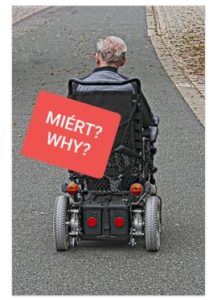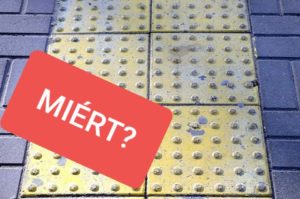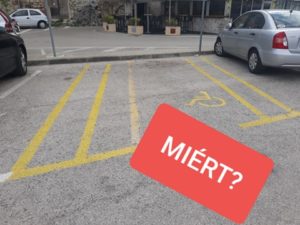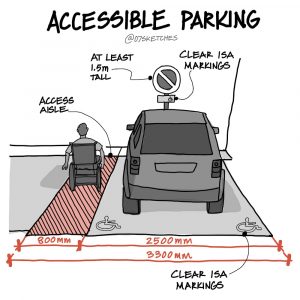It might be strange that we support straws when every respectable restaurant is withdrawing those environment damaging tubes. Even though they are necessary for most disabled people so because of being barrier-free some cafés will have to keep some in their inventory – in an environment friendly form.
But why do we need straws? I’ll present it for you with an easy example, a personal experience: about six months ago I was at a conference where they didn’t have any glasses for disabled people and I thought that I’m not going to embarrass myself by using a straw, I’ll drink out of the ceramic mug. For the sake of ease I always keep my bag in my lap. Needless to say that after my attempt neither was I nor the stuff in my bag thirsty anymore under the pretext of drying on the radiator.
Inhibited people or people in wheelchairs are not only unable to move their legs but usually they can’t use their hands in all aspects. They’re missing the skill of lifting, squeezing, or they have muscle weakness but there could be many reasons that makes them unable to grip or lift a glass. However, you need to drink.
Nevertheless the mass produced unrecyclable straws are expired. We don’t stand by them either. But there are great alternatives: washable plastic and metal ones, degradable ones. These are not only environmentally conscious – the kind we like – but also appropriate for disabled people as well.
That’s how born at the same time people-, and eco-friendly solutions!
Written by Roland Balogh

Able bodied people walk on them easily. They only get bothered by a wall-mounted car or by the pavement being torn up. The sidewalk for people in wheelchairs though is a real obstacle course.
Getting on the footway in the city centres is easier because of the recessed design of the curbs but it’s much more difficult if there is a berm. The most problematic thing is probably the ascension and the descension of electric wheelchairs because they weigh 100kgs.
And we can’t get relief even if we’re on the pavement. We have to face multitude of barriers: the sidewalk being torn up, asphalt fragments, cobbles, stairs formed in steep streets, car exits, ruptured parts from the roots of trees, uncovered drains, protruding steps, outsourced advertising signs, old quarter’s narrow though ‘romantic’ lanes, cars parked on the footway, bus stop on the sidewalk.
So we are sometimes forced to go (slowly) on the roads willy-nilly with our electric mopeds taking in account the risk of accidents, keeping the traffic, the driver’s repatriation.
If it’s already like that what can we – people in wheelchairs do? We plan our routes early, we go on roads with little traffic, and we explore the unknown crossroads with the help of Google Map’s street view function.
Written by Zoltán Koppány

Because in wheelchair sitting we need a bit different accommodations: higher bed as the average (58-60 cm) which is a level in the wheelchair that allows of lifting somebody.
The room door is wider, there is no threshold and carpet. The room is so big that the car can turn, the handles, switches are available and if it possible there are sliding doors. The red wire hanging from the wall needed for help request.
In the bathroom are the biggest weirdnesses: there is no shower tray because we couldn’t roll in with wheelchair. We need there a folding seat, and on both sides of the toilet properly equipped clingings. A bigger place is also needed here. Under the sink there must be access to a wheelchair and the mirror has to be lower or adjustable.
Maybe this all sounds like a lot but it’s the only way we can travel. A barrier-free accommodation usually can be created with good intentions without a problem.
It’s good to be on your guard and before booking a room should be consulted the reception if the barrier-free advertised hotel really is!
Thank you for reading this!
And thank you for Alexa Dékán and Zoltán Koppány the assistance in the description!
nother piece of our WHY? campaign:
Have you ever seen “something” during your city walks, in public institutions or somewhere else, that stands out on the floor and has a different colour? So this is the blind guide lane, that makes access easier for blind people.
The right blind guide lanes are higher than the pavement therefore can be perceived with the white stick and if you step on it. They are marked with distinctive colour for those who can still see a little bit.
Usually they are made for two purposes:
- Indicating direction for those who can’t see in front of them at all, especially the absolutely blind people. The guide lane is followable, provides security when approaching frequently visited objects (e.g. crosswalk, toilets, junctions, tracks at the train station).
- As warning signals, most commonly at junctions and at the end of the sidewalk. This is a well perceivable dotted surface, also with feet and this is even a little higher. Near crosswalk and stairs it can save lives.
Blind guide lanes are very useful but only if they have been made with expertise. Unfortunately there are many negative examples. Sometimes the lane has no end, it disappears after a while or there is nothing to follow after the starting direction. It also happens that the lane brings the person in the wrong direction: to the building’s walls, shop-window or drive-way.
There are very few blind guide lanes in Hungary, they can be found only at the busiest locations of cities.
Thank you to our members Róbert Rauch of sharing experience!
(MIÉRT? = WHY?) 
Disability vehicles are often larger by design, as wheelchairs have to fit in them.
The size of the front passenger door and how wide it can be opened is a crucial aspect: the wider the door opens the easier it is to roll close to the car and get into the front passenger seat. However to do this you need room. This is (only) one of the reasons why disabled parking spots are so wide.
To get into the front passenger seat you need someone to help. The wheelchair needs to be right next to the car and there has to be extra room for the person helping.
Getting into the seat is an art in itself and most of us have developed our own tricks. One thing is for sure though, it requires space, time, lots of patience and calm circumstances. The helper and the disabled person need to coordinate every single movement, and this requires lots of space.
When arriving in a van, a ramp needs to be attached either to the side or the back of the car for the disabled person to get out. This requires space too.
Thank you for our member Koppány Zoltán the description!








